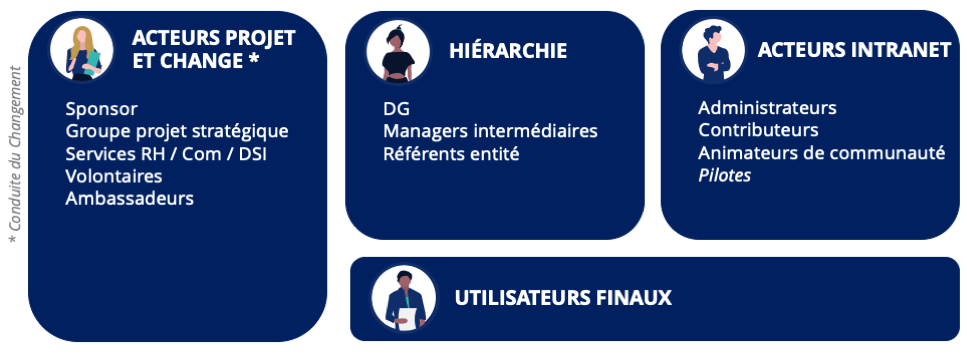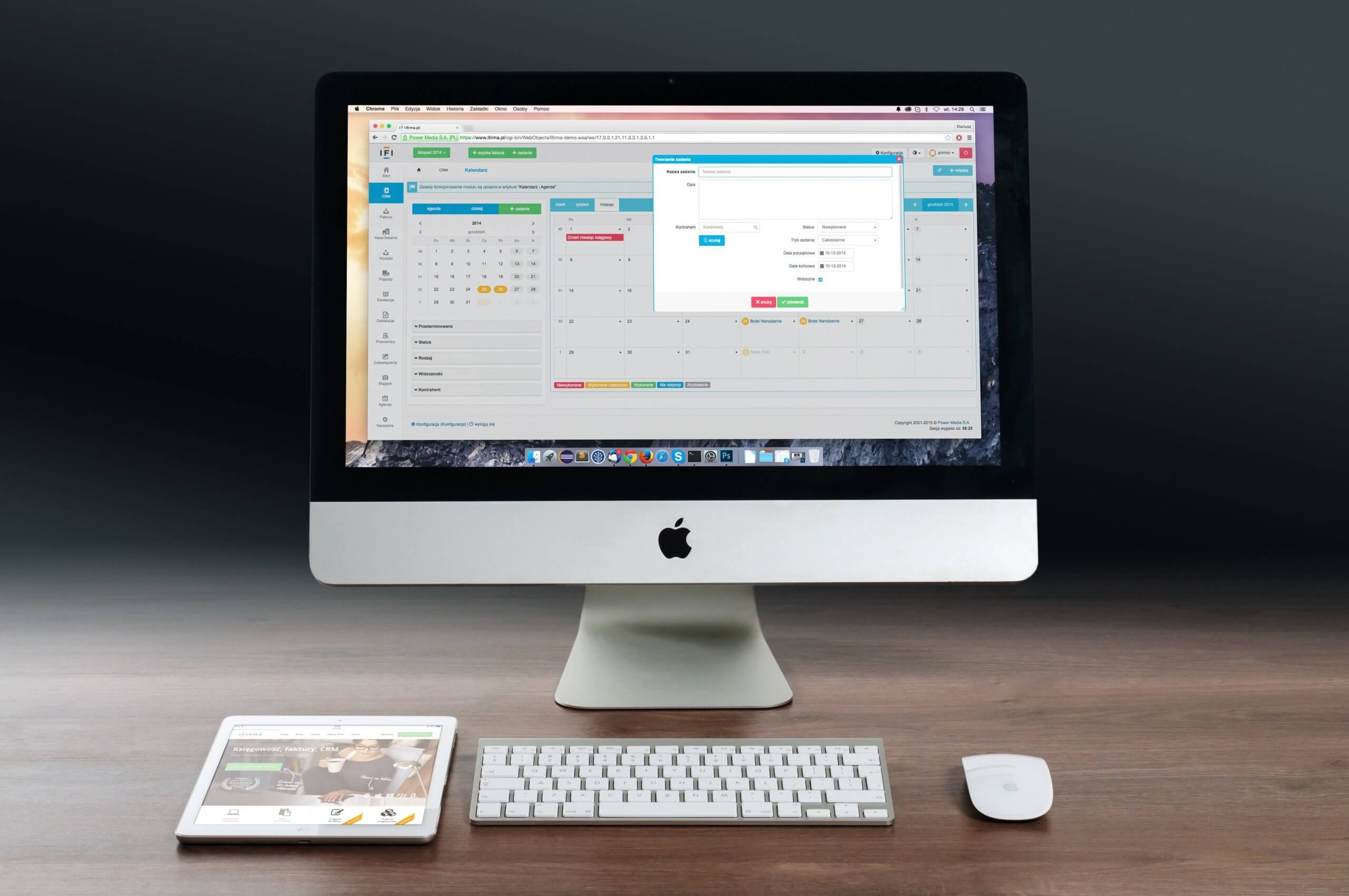The Digital Workplace: a more collaborative face for your organization
The objectives of a Digital Workplace are multiple, such as making the organization more transversal, more communicative and, of course, more fluid. In addition, the tool’s new functionalities make it more employee-oriented. As a result, your information system changes, and so the angle brought to your organization becomes more “social”:
- The employee is at the heart of the Digital Workplace. In fact, he tends to bring the platform to life through his own contributions,
- The Digital Workplace of tomorrow is enriched by a more collaborative and social vision,
- Information becomes more targeted. Employees see the intranet as a relevant and useful platform,
- New formats (videos, photos) make theintranet more human. Video interviews with employees can be integrated (e.g., feedback from internal events).
However, this vision remains theoretical if certain internal elements remain unchanged. According to theObservatoire Intranet et Digital Working 2019, 34% of companies have neither formalized rules nor procedures. Hence the importance of integrating intranet use into your IS. But also, to support this change, management must inevitably be present. Its role will be to promote the intranet by advocating this new digital culture.
Draw any change through the prism of the employee before launching your intranet project
Differentiating between change management terms
To initiate change in your organization, let’s differentiate between two terms :
- Change : identified at a specific date,
- Transition : nurturing and accelerating a social dynamic to set the organization in motion (towards the set objectives).
In an intranet project, the change is the date of the tool’s official launch. The transition is the path (the digital and change management strategy) to take to achieve adoption.
Change management must take into account the goals, challenges and impacts of the various components of the organization:
- Corporate culture,
- Internal organization,
- Management,
- Individuals.
The aim is to reduce the organizational and psychological impact of this change. But also, to establish a work ecosystem that is viable over the long term. The main objective of any digital transformation is to match functionalities to business uses, and not the other way around.
To manage the project properly, break it down into 4 phases
There are four main stages in this agile, collaborative project:
- Anticipation – design : Preparation, identification of impacts, implementation of the strategic plan with defined governance, informational communication on the project, co-design workshops with a user/employee panel,
- Experimentation – adjustment : Pilot phase with a sample of testers, collection and capitalization of feedback, adjustment of the tool and support strategy,
- Official launch : Extensive communication with support from management, fun launch, tool discovery,
- Follow-up – enhancement – adjustment : Training, more specific support for certain populations, collection of success stories, enhancement of intranet use by management, adjustment of the tool and defined uses.
Actions to encourage Digital Workplace adoption and employee engagement
The first step is to create an internal dynamic, and the second is to maintain it. Fostering commitment depends above all on your attitude: listen to your employees and be close to them. They need to feel involved, not “forced” by a strategy coming from the “top”, from management.
To promote change management and social dynamism, the 6 elements to consider are :
- Communicate about the change to everyone in your digital project perimeter (directly or indirectly): upstream, during and after to announce the project, objectives and methodology.
- Meeting people: to bring the project to life and make it more visible by going directly to them to inform them about the project, especially for unconnected or decentralized populations.
- Engage motivated volunteers: to legitimize the tool locally and support its interest through the promotion of these specific users. We’ll call them “ambassadors”.
- Co-design collective workshops with the project group and users : to produce a tool that is well adapted to their needs, to enhance the value of their work and to legitimize the tool through their involvement in the project.
- Train your employees on the tool, its new uses and their new role: to reduce fears linked to skills in the use of the tool itself and their legitimacy in the face of the transformation of their role.
- Reward all employees for their contribution: to encourage their participation both upstream (by organizing co-construction workshops) and downstream (by rewarding their use of the intranet). Encouragement is provided by both management (take advantage of your intranet’s news feed to communicate) and managers.
Your employees: agents of change in your Digital Workplace project
Break down your organization into 4 major families
Create an internal dynamic, so that everyone is involved in the project at their own level. Classify your employees according to their position and role in your organization and in the project. Your strategic plan will be built on this basis.
The 4 main families of people involved in your project are :
Identifying these different players will enable us to focus our communication and training efforts on different issues and objectives. As a result, the strategic support plan will need to be modified and enriched over the course of the project. This is why we advise you to define a governance structure and project bodies. Please note that the “tool design” project group may be different from the “change management” project group, depending on the scope of support you have determined.
Of course, all these players are important in digital transformation projects. However, particular attention is paid to one profile: the middle manager. By virtue of his or her position, the manager is responsible for getting the message across, and can short-circuit the change process if he or she is not interested in the project.
If the manager (or top management) doesn’t set an example, the project is likely to fail, or not achieve the desired objectives. The cross-functional nature of your future organization means that the manager will be less likely to centralize information. That’s why we offer you specific support for these managers, to alleviate their fear of losing power. Training them in their new role as “team coordinator” (and not “controller”) is a must if they are to become a manager 2.0, or even 3.0.
Three project groups for your digital transformation
- The project manager is our direct contact for project follow-up. He can be supported by a team of two.
- The restricted project group steers the project and validates the major decisions. For the most global vision, three business referents should ideally be represented: IT, COM and HR. The sponsor can also take part in the development of the project.
- The extended project group, where a panel of users and contributors is added to the restricted group. We’ll gather their real-life experiences and map out their daily lives through workshops (roundtables, interviews) or surveys. At the same time, these workshops will enable us to carry out an informal diagnostic to measure their digital maturity and their behavior in the face of change. This makes it easier to identify their needs, obstacles and motivating factors. What’s more, by inviting them along, the acculturation process begins, making it easier to identify your future ambassadors.
Conclusion
Generally speaking, digital transformation is directly transforming the jobs, roles and skills known today. Indeed, the information system changes, as do all your organization’s procedures. Teams need to coordinate differently and learn new ways of working together. And let’s not forget theimportance of hierarchy in such a model, by embodying a legitimate and exemplary posture, which will bring a stronger sense of proximity.
More than just a tool, the intranet is changing the way we and access information. And some may be less experienced than others. Hence the need to move collectively to create a positive internal dynamic, and involve your employees directly in these digital projects.
In short, you need to pay particular attention to all your employees to make this “transition” as smooth as possible, so that they are convinced of this “change”. Digital is a major challenge. Your company’s digital transformation is everyone’s business, at every level. #colibri







